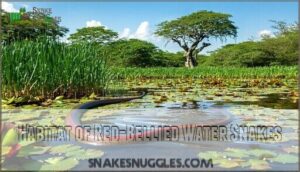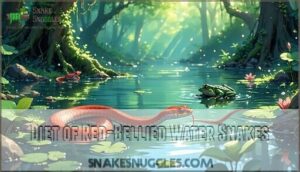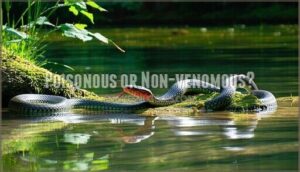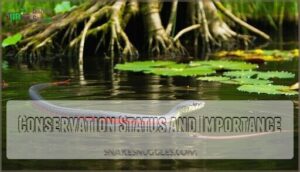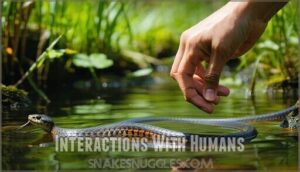This site is supported by our readers. We may earn a commission, at no cost to you, if you purchase through links.
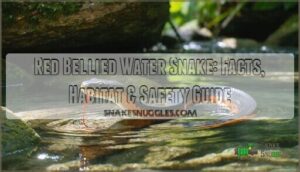
These fascinating reptiles inhabit wetlands across the southeastern United States, from Virginia to Texas, where they’ve mastered the art of ambush hunting along shorelines.
With their distinctive keeled scales creating a rough texture and that telltale bright orange belly, they’re easier to identify than you’d think.
Adults typically stretch 30-48 inches and feed primarily on frogs, toads, and fish, making them nature’s own pest control specialists.
Their territorial nature means they’ll return to the same basking spots repeatedly, and while they might put on quite the defensive show with coiling and musky secretions, remember that their bite is worse than their bark—which isn’t saying much since they can’t actually bark.
Table Of Contents
- Key Takeaways
- Red-Bellied Water Snake Overview
- Habitat of Red-Bellied Water Snakes
- Diet of Red-Bellied Water Snakes
- Venom and Toxicity Concerns
- Conservation Status and Importance
- Interactions With Humans
- Frequently Asked Questions (FAQs)
- Where do red-bellied water snakes live?
- What happens if a water snake bites you?
- Is a red belly water snake poisonous?
- Are plain bellied water snakes good to have around?
- Is the red-bellied snake venomous?
- Are Red-bellied Snakes poisonous in NC?
- Can red-bellied water snakes be kept as pets?
- What are their natural predators in the wild?
- How do they communicate with each other?
- How long do red-bellied water snakes live?
- Conclusion
Key Takeaways
- You’ll encounter a completely harmless, non-venomous snake that’s often mistaken for dangerous water moccasins—they can’t poison you despite their aggressive defensive displays
- You can identify them by their distinctive orange-red belly and rough, keeled scales, with adults typically measuring 30-48 inches long
- They’re beneficial for your property as nature’s pest control, feeding primarily on frogs, toads, and fish to help maintain ecosystem balance
- You’ll find them in wetlands across the southeastern U.S. where they prefer shallow waters with dense vegetation for hunting and basking
Red-Bellied Water Snake Overview
You’ll encounter the red-bellied water snake (Nerodia erythrogaster) throughout wetlands and waterways, where it’s often confused with venomous species despite being completely harmless.
This non-venomous snake displays distinctive orange to red belly coloring that contrasts sharply with its dark brown or gray back, making identification easier once you know what to look for, and its coloring is a key feature.
Physical Characteristics
You’ll recognize the red bellied water snake by its distinctive keeled scales that create a rough, bumpy texture along its dorsal scales.
This snake’s most striking feature is its unmarked orange belly that contrasts dramatically with its dark brown or gray body pattern.
Adults typically reach 30-48 inches in snake length, while juveniles display banded markings that fade as they mature into their characteristic snake appearance.
The unique texture of snake scale patterns plays a vital role in the snake’s ability to move and hunt effectively, utilizing its distinctive keeled scales and unmarked orange belly to its advantage, with a focus on its dorsal scales.
Behavior
Beyond their striking appearance, red-bellied water snakes showcase remarkable behavioral adaptations.
You’ll observe these non venomous snakes demonstrating sophisticated snake behavior patterns throughout their active seasons.
These aquatic snakes employ diverse strategies for survival, from aggressive defense displays to complex social interactions during breeding periods.
Their behavioral repertoire includes:
- Aggressive Defense – Coiling, striking, and releasing foul musk when threatened
- Hunting Tactics – Ambush feeding along shorelines during twilight hours
- Territorial Behavior – Returning to established basking and foraging locations
- Escape Mechanisms – Rapid retreat into vegetation rather than water
Reproduction
Red-bellied water snakes showcase fascinating mating habits during spring when males compete for gravid females.
Spring brings intense competition as male red-bellied water snakes battle fiercely for breeding rights with females.
Their reproductive cycle includes a gestation period of 3.5 months before viviparous birth occurs.
Birth rates vary dramatically, with litter size ranging from 6-50 offspring per female.
Unlike egg-laying species, these snakes give live birth in early fall.
Spring birthing timing helps juveniles establish territories before winter.
Remarkably, females can store viable sperm for two years, ensuring successful snake reproduction even when mates are scarce.
No offspring care follows birth.
Habitat of Red-Bellied Water Snakes
You’ll find red-bellied water snakes thriving in wetlands, swamps, and areas near temporary water sources where amphibians are abundant.
These adaptable reptiles range across the southeastern United States, from Virginia down to Florida and west to Texas, preferring shallow waters with dense vegetation for hunting and shelter, which makes them well-suited to their environment with dense vegetation.
Preferred Environments
Throughout their range, you’ll find red-bellied water snakes thriving in diverse aquatic habitats that offer both water access and terrestrial shelter.
Red-bellied water snakes flourish in wetlands where water meets land, creating perfect hunting grounds
These freshwater snakes prefer environments that blend wetland and upland features perfectly. The species is well adapted to its native aquatic environments with specific habitat preferences.
Here are their top habitat preferences:
- Wetland areas including marshes, swamps, and slow-moving streams
- Water bodies like ponds, lakes, and quiet river backwaters
- Floodplains with abundant vegetation and muddy bottoms
- Rocky shores and brush piles near water for basking
- Aquatic environments with nearby upland corridors for seasonal movement
These water snake habitats in the southeastern United States provide essential cover, prey abundance, and temperature regulation opportunities that support their survival needs.
Geographic Distribution
You’ll discover Nerodia erythrogaster spans the southeastern United States, from Virginia to Florida and westward to Texas.
Regional variations in distribution patterns reflect habitat availability and climatic conditions across North America.
| Region | Primary Range |
|---|---|
| Atlantic Coast | Virginia to Florida |
| Gulf States | Alabama to Texas |
| Interior Lowlands | Arkansas to Kentucky |
This geographic distribution across the southeastern Coastal Plain creates diverse spatial migration opportunities as seasons change.
Diet of Red-Bellied Water Snakes
You’ll find that red-bellied water snakes aren’t picky eaters, with amphibians making up the bulk of their diet.
These opportunistic hunters primarily target frogs, toads, and salamanders, though they’ll also snatch fish and small invertebrates when the opportunity arises.
Primary Food Sources
Red-bellied water snakes maintain diverse diets centered on amphibian prey.
Their feeding preferences include three primary categories:
- Frogs and toads – comprising over 60% of their diet
- Salamanders – both larval and adult forms
- Fish – especially from shallow wetlands
These serpents also consume aquatic invertebrates, slug consumption occurs seasonally, and small mammals occasionally supplement their meals when available near water sources.
The snakes’ geographic distribution and preferred aquatic habitats play a significant role in their feeding behavior.
Feeding Behavior
Patience defines successful red-bellied water snake foraging tactics. You’ll observe these aquatic hunters using ambush strategies, remaining motionless until frogs venture within striking distance.
Red-bellied water snakes master the art of motionless hunting, striking with lightning precision when prey approaches
Their hunting strategies adapt to different water snakes’ dietary needs across aquatic environments. These remarkable predators demonstrate incredible feeding habits, adjusting their diet based on prey abundance in their wetland homes.
| Feeding Aspect | Behavior | Timing |
|---|---|---|
| Prey Capture | Lightning-fast strike | Dawn/dusk hours |
| Snake Diet Focus | Amphibians preferred | Year-round availability |
| Feeding Habits | Swallow whole | Post-capture immediately |
| Diet Adaptation | Opportunistic approach | Seasonal flexibility |
Venom and Toxicity Concerns
You’ll be relieved to know that red-bellied water snakes are completely non-venomous, despite often being mistaken for their dangerous cousin, the water moccasin.
While they can’t poison you, these feisty snakes will bite aggressively when threatened and can cause painful wounds with their sharp teeth.
Poisonous or Non-venomous?
Despite its intimidating appearance, you’ll find the red-bellied water snake is completely nonvenomous and non-venomous.
This water snake produces no venom effects or toxicity levels that threaten humans.
When threatened, its defense mechanisms include aggressive striking and releasing foul musk, but snake bites cause only minor wounds.
These snake bite incidents result in mechanical injury, not envenomation.
Understanding these water snake facts helps distinguish this harmless species from truly venomous cottonmouths, despite frequent misidentification due to similar aquatic habitats and poisonous-looking coloration.
The identification of non venomous snakes is essential for maintaining a safe environment and can be achieved by learning about their characteristic traits.
Risks to Humans
Even though red-bellied water snakes aren’t venomous, their defensive nature can lead to painful encounters if you’re not careful.
These nonvenomous serpents pack sharp teeth that’ll leave you with puncture wounds and potential infection risks when they feel cornered.
Bite Risks and Defense Mechanisms:
- Aggressive bite behavior – They’ll strike repeatedly when threatened, using needle-sharp teeth
- Foul musk release – Defense mechanisms include spraying terrible-smelling secretions during attacks
- Mistaken identity dangers – Often confused with dangerous water moccasins, leading to unnecessary panic
- Human safety concerns – While not dangerous to humans, infection from snake bite wounds requires proper wound care
It’s essential to have a snake bite kit for emergency situations to guarantee proper treatment and minimize infection risks.
Conservation Status and Importance
Red-bellied water snakes face habitat loss from wetland destruction and development, but they’re currently stable across most of their range.
You’ll find these snakes play a vital role in controlling amphibian populations, making their conservation important for maintaining healthy ecosystem balance.
Threats Faced
Red-bellied water snakes battle mounting pressures across their range.
Habitat Loss from urban expansion has eliminated 30% of their natural wetlands since 1990, while Human Encroachment fragments remaining territories.
Pollution Effects from pesticide runoff poison both snakes and their amphibian prey.
Climate Change brings droughts that dry up essential breeding pools, and Predation Risks intensify as invasive species compete for food.
Human persecution compounds these snake threats, with 46% of people mistakenly identifying them as venomous, leading to unnecessary killings.
Conservation Efforts
Wildlife Conservation initiatives actively protect red-bellied water snakes through thorough Habitat Preservation programs targeting wetland ecosystems.
You’ll find Species Protection efforts focus on Environmental Sustainability through these key strategies:
- Ecosystem Management of mesic southern forests and wet meadows
- Water snake habitat corridor development connecting fragmented populations
- Population monitoring through research and tracking programs
- Reptile conservation via captive breeding initiatives
- Snake conservation education promoting coexistence with humans
These coordinated conservation efforts guarantee endangered species like red-bellied water snakes maintain stable populations across their native ranges.
Understanding the role of species profile is vital for effective conservation planning and management of ecosystems.
Interactions With Humans
You’ll likely encounter red-bellied water snakes near wetlands, ponds, or streams where they hunt for frogs and fish.
These non-venomous snakes actually benefit you by controlling pest populations, though they’ll bite defensively if you handle them carelessly.
Encounters in The Wild
Along hiking trails and fishing spots, you’ll likely encounter these semi-aquatic reptiles during warm months.
Wild sightings increase near wetlands where water snakes bask on logs or rocks. Most wildlife encounters remain peaceful if you maintain distance.
However, habitat invasion through development forces snake encounters closer to human activity, making reptile wildlife awareness essential for safe wetland exploration.
Understanding wild snake behaviors is vital for minimizing risks during snake encounter situations, which is crucial for a safe experience.
Benefits or Concerns
You’ll discover that redbellied water snake encounters bring more benefits than concerns to your local environment.
These non-venomous reptiles play a vital Ecological Role in maintaining natural balance while posing minimal Human Safety risks.
Conservation Value considerations include:
- Population control of amphibians and small fish
- Environmental Concerns from habitat loss and pollution
- Economic benefits through reduced pest populations
- Indicator species for healthy waterway ecosystems
- Snake conservation status varies regionally across habitats
Understanding their Economic Impact helps you appreciate why conservation efforts matter for ecosystem stability.
Effective snake conservation requires the use of proper snake conservation tools to support these initiatives.
Frequently Asked Questions (FAQs)
Where do red-bellied water snakes live?
You’ll find these snakes throughout the southeastern United States, from Virginia down to Florida and west to Texas.
They prefer freshwater habitats like ponds, swamps, and slow-moving streams, often wandering surprisingly far from water sources.
What happens if a water snake bites you?
If you’re bitten by a water snake, you’ll experience puncture wounds and bleeding from their sharp teeth.
Clean the wound thoroughly, apply antiseptic, and monitor for infection since they’re non-venomous but bacteria-laden.
Is a red belly water snake poisonous?
Red-bellied water snakes aren’t poisonous or venomous—they’re completely harmless to you.
While they’ll bite defensively and release foul-smelling musk when threatened, you won’t experience any toxic effects from their bite.
Are plain bellied water snakes good to have around?
Plain-bellied water snakes are beneficial neighbors that control amphibian populations and rarely threaten humans.
You’ll appreciate their pest control services, though they’re aggressive when cornered and produce foul-smelling musk as defense.
Is the red-bellied snake venomous?
No, you don’t need to worry about venom when you encounter this water snake. Red-bellied water snakes are completely non-venomous, though they’ll bite defensively and release foul-smelling musk when threatened.
Are Red-bellied Snakes poisonous in NC?
Like a harmless garden visitor, you’ll find these snakes aren’t poisonous in North Carolina.
Red-bellied water snakes lack venom entirely, making them completely safe despite their defensive displays and aggressive behavior when threatened, which can be summarized as completely safe.
Can red-bellied water snakes be kept as pets?
Keeping these snakes as pets isn’t recommended due to their aggressive nature, specific habitat requirements, and challenging dietary needs.
They’ll bite repeatedly, release foul-smelling musk when stressed, and often refuse food in captivity, creating serious health risks.
What are their natural predators in the wild?
Natural predators include birds of prey like hawks and eagles, large fish such as bass and pike, snapping turtles, raccoons, and other snakes.
You’ll find these threats vary by habitat and the snake’s size.
How do they communicate with each other?
Studies show mating groups form "cords" with multiple males competing for females through chemical cues.
You’ll find these snakes communicate primarily through pheromones and tactile signals during breeding season, with limited vocal communication compared to other species.
How long do red-bellied water snakes live?
You’ll find these snakes can live around 10 years in the wild, though some push past that with luck.
Their secretive habits and tough nature help them dodge predators, but captivity rarely stretches their lifespan much longer.
Conclusion
Understanding your local red-bellied water snake transforms fear into fascination.
You’ve discovered these remarkable reptiles aren’t venomous threats but beneficial neighbors controlling amphibian populations in wetland ecosystems.
When you encounter one basking near water, remember they’re more afraid of you than you’re of them.
Their defensive displays are pure theater—impressive but harmless, and by respecting their space and appreciating their ecological role, you’ll coexist peacefully with these misunderstood aquatic hunters, who play a crucial part in maintaining the balance of wetland ecosystems.
- https://www.britannica.com/science/ectotherm
- https://www.nwf.org/Educational-Resources/Wildlife-Guide/Threats-to-Wildlife/Habitat-Loss
- https://www.wildlife.vic.gov.au/__data/assets/pdf_file/0016/84112/Red-bellied-Black-Snake.pdf
- https://www.virginiaherpetologicalsociety.com/reptiles/snakes/plain-bellied-watersnake/plain-bellied-watersnake.php
- https://www.worldwildlife.org/species/directory?direction=desc&page=2&sort=extinction_status

